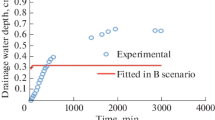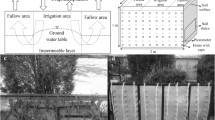Abstract
A transient drainage simulation model,SWAP, was used to evaluate the performanceof drainage systems in (semi-) arid zones.Before application, the model wascalibrated by using 14-months datacollected from two sample fields of theFourth Drainage Project (FDP), Punjab,Pakistan. During the calibration process,emphasis was given to the accuratedetermination of soil hydraulic parameters,reference evapotranspiration, drainage fromsample fields and bottom boundarycondition. Laboratory determined soilhydraulic parameters were foundnon-representative of the field conditions.Difference between laboratory and fielddetermined soil water retention curves werefound significant. The pressure heads andsoil water contents measured in depthincrements of 15 cm were in good agreementwith the simulated values after applying afield measured retention curve. A closeproximity was also found between measuredand simulated average root zone salinity at0–1.0 m depth. The referenceevapotranspiration calculated by thePriestly-Taylor (PT-ET o) methodwas found physically more realistic thanthe Penman-Monteith (PM-ET o)method due to ignorance of the feed backmechanism of vapor pressure deficit onstomatal closure. The simulated cumulativedrainage from two sample fields wascomparable with the calculated values. Theanalysis of piezometer data shows thatthere is a negligible water exchangebetween the deep aquifer and theunsaturated zone. Therefore for scenarioanalysis, no flow conditions at the bottomof the soil profile can be applied as abottom boundary.
Similar content being viewed by others
References
Allen, R.G., Smith, M., Perier, A. & Pereira, L.S. 1994. An update for the definition of reference evapotranspiration. ICID Bulletin, 43(2): 1-34.
Bastiaanssen, W.G.M., Singh R., Kumar, S., Schakel, J.K. & Jhorar, R.K. 1996. Analysis and recommendations for integrated on-farm water management in Haryana, India: a model approach. DLO Winand Staring Centre, Report 118, 152 pp. Wageningen, The Netherlands.
Bastiaanssen,W.G.M., El-Deen Milad Soliman, K.,Mirabile, C., Korani, M. & Abdel Gawad, S. 1996. Data management related to the application of two crop-water-environment models in Argentina and Egypt. Proceedings of the 16th ICID Congress, Cairo, Egypt. pp. 54-68.
Beekma, J. 1993. Application of soil parameters in land reclamation for balanced agricultural development and environmental management. IWASRI Report 152, Lahore, Pakistan.
Beekma, J., Raza, Z.I. & Boers, Th.M., 1994. Calibration of EM38 for salinity assessment in the Fourth Drainage Project, Pakistan. IWASRI Report 120, Lahore, Pakistan.
Beekma, J., Kelleners, T.J., Boers, Th.M. & Raza, Z.I. 1995. Application of SWATRE to evaluate drainage of an irrigated field in the Indus Plain, Pakistan. In: L.S. Pereira et al. (Eds.), Crop-Water-Simulation Models in Practice, Wageningen Press, Wageningen, The Netherlands, pp. 141-160.
Belmans, C., Wesseling, J.G. & Feddes, R.A., Simulation of the waterbalance of a cropped soil: SWATRE. J. Hydrol. 63: 217-286.
Black, T.A., Gardner, W.R. & Thertell, W. 1969. The prediction of evaporation, drainage, and soil water storage for a bare soil. Soil Sci. Soc. Am. J. 33: 655-660.
Boesten, J.J.T.I. & Stroonsnijder, L., 1986. Simple model for daily evaporation from fallow tilled soil under spring conditions in a temperate climate. Netherlands Journal of Agricultural Science 4: 75-90.
Boesten, J.J.T.I. & van der Linden, A.M.A. 1991. Modeling the influence of sorption and transformation on pesticide leaching and persistence. Journal. Envi. Quality 20: 425-435.
De Zeeuw, J.W. & Hellinga, F. 1958. —Neerslag en afvoer, Landbouwkundig Tijdschrift 70: 405-422 (in Dutch with English summary).
Dumm, L.D. 1960. Validity and use of the transient flow concept in subsurface drainage. Paper presented at ASAE meeting, Memphis, Tenn, Dec. pp. 4-7.
Feddes, R.A., Kawalik, P.J. & Zaradny, H., 1978. Simulation of water use and crop yield. Simulation Monogr, PUDOC, Wageningen, 188 pp.
Feddes, R.A. 1988. Effects of drainage on crops and farm management. Agricultural Water Management 14: 3-18.
Feddes, R.A, Kabat, P., Bakel, P.J.T., Bronswijk, J.J.B. & Halbertsma, J., 1988. Modelling soil water dynamics in the unsaturated zone-state of the art. J. Hydrol. 100: 69-111.
Feddes, R.A. 1990. Proposal on non-steady state water management model for horizontal drainage design. Assistance to IWASRI, Lahore, Pakistan. Mission Report. 31 pp.
Homaee, M. 1999. Root water uptake under non-uniform transient salinity and water stress. Ph.D. thesis, Wageningen Agricultural University, The Netherlands. 173 pp.
IWASRI 1990. Detailed soil survey of S1B9 area, Fourth Drainage Project, Faisalabad. Internal Report No. 90/11, IWASRI, Lahore, Pakistan. 28 pp.
IWASRI 1994. Watertable control in design and practice for pipe drainage systems in Pakistan. Internal Report No. 94/17, IWASRI, Lahore, Pakistan, 106 pp.
Kelleners, T.J. 1994. Use of SWATRE to simulate water and salt balance of an irrigated field in the Indus Plain of Pakistan. IWASRI Report 140, Lahore, Pakistan. 42 pp. 279
Kool, J.B., & Parker, J.C. 1987. Development and evaluation of closed-form expressions for hysteretic soil hydraulic properties. Water Resour. Res. 23(1): 105-114.
Krayenhoff, van de Leur, D.A. 1958. A study of non-steady groundwater flow with special reference to a reservior-coefficient. I. Ingenieur 70: B87-94.
Krayenhoff, van de Leur, D.A. 1962. A study of non-steady groundwater flow. II. I. Ingenieur 74: B285-292.
Kumar, S. & Bastiaanssen, W.G.M. 1993. Simulation of the water balance in relation to crop water requirement in (semi-) arid zones. Question 44, R 28, The Hague, The Netherlands. pp. 349-368.
Maasland, M. 1959. Watertable fluctuations induced by intermittent recharge. Journal of Geophysics Research 64: 549-559.
McAneney, K.J. & Itier, B. 1996. Operational limits to the Priestly-Taylor formula. Irrigation Science 17: 37-43.
McNeill, J.D. 1986. Geonics EM38 ground conductivity meter. Tech. Note TN-21. Geonics Ltd., Mississauga, Ontario, Canada.
Mualem, Y. 1976. A new model for predicting the hydraulic conductivity of unsaturated porous media. Water Resour. Res. 12(3): 513-521.
Nielsen, D.R., Van Genuchten, M.Th. & Bigger, J.W. 1986. Water flow and solute transport processes in the unsaturated zone. Water Resour. Res. 22(9): 89S-108S.
Paw U, K.T. & Gao, W. 1988. Applications of solutions to non-linear energy budget equations. Agr. And Forest Met. 43: 121-145.
Prasad, R. 1988. A linear root water uptake model. J. Hydrol. Vol. 99: 297-306.
Priestley, C.H.B. & Taylor, R.J. 1972. On the assessment of surface flux and evaporation using large-scale parameters. Mon. Weather Rev. 100: 81-92.
Ritzema, H.P., (ed.) 1994. Drainage principles and applications. ILRI Publication No. 16, Wageningen, The Netherlands.
Sarwar, A. 1993. Application of SWATRE to predict soil water flow in a lysimeter. IWASRI Publication No. 141. International Waterlogging and Salinity Research Institute, Lahore, Pakistan. 53 pp.
Smets, S.M.P., Kuper, M., Van Dam, J.C. & Feddes, R.A. 1997. Salinization and crop transpiration of irrigated fields in Pakistan's Punjab. Agri. Water Manag. 35: 43-60.
Smith, M., Allen, R.G., Perier A. & Pereira, L. 1990. Expert consultation on revision of FAO methodologies for crop water requirements. Internal Report FAO: 54 pp.
Topp, G.C., Davis, J.L. & Annan, A.P., 1980. Electromagnetic determination of soil water content: Measurement in coaxial transmission lines. Water. Resour. Res. 16: 574.
U.S. Bureau of Reclamation. 1989. Design memorandum subsurface drainage Fourth Drainage Project, lower remaining Rechna subproject, Faisalabad. U.S. Dept. of Interior, Bureau of Reclamation, and WAPDA, Lahore, Pakistan. 49 pp.
Van Dam, J.C., Stricker, J.N.M. & Droogers, P. 1994. Inverse method to determine soil hydraulic functions from multi-step outflow experiments. Soil Sci. Soc. Am. J. 58: 647-652.
Van Dam, J.C. & Feddes, R.A. 1996. Modeling of water flow and solute transport for irrigation and drainage. In: L.S. Pereira et al. (Eds.), Sustainability of Irrigated Agriculture. Kluwer Academic Publishers, the Netherlands, pp. 211-231.
Van Dam, J.C., Huygen, J., Wesseling, J.G., Feddes, R.A., Kabat, P. & Van Walsum, P.E.V. 1997. Simulation of transport processes in the Soil-Water-Air-Plant environment. SWAP user's manual. DLO-Winand Staring Centre, Wageningen, The Netherlands.
Van Genuchten, M.Th. 1987. A numerical model for water and solute movement in and below the root zone. Res. Report. US Salinity Laboratory, Riverside, CA.
Vlotman, W.F., Sufi, A.B. & Sheikh, I.A., 1990. Comparison of three subsurface pipe drainage projects in Pakistan. Proceedings of the symposium on land drainage for salinity control in arid and semi-arid regions, Cairo, Egypt.
WAPDA 1983. Project report Muhajir Branch unit Thal canal SCARP. Publication No. 32, WAPDA, Lahore, Pakistan. 154 pp.
Wijk, A.L.M. Van & Feddes, R.A. 1986. Simulating effects of soil type and drainage on arable crop yields. In: A.L.M. van Wijk and J. Wesseling (Eds.). AgriculturalWater Management. Proc. Symp. on Agric. Wat. Manag., Arnhem.
Author information
Authors and Affiliations
Rights and permissions
About this article
Cite this article
Sarwar, A., Bastiaanssen, W., Boers, T. et al. Devaluating Drainage Design Parameters for the Fourth Drainage Project, Pakistan by using SWAP Model: Part I – Calibration. Irrigation and Drainage Systems 14, 257–280 (2000). https://doi.org/10.1023/A:1006468905194
Issue Date:
DOI: https://doi.org/10.1023/A:1006468905194




